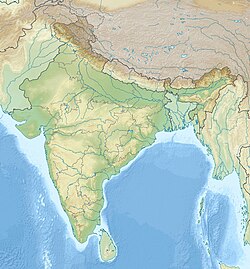Dharanikota
Dharanikota
Dhanyakatakam | |
|---|---|
Village | |
 Residential area in Dharanikota | |
| Nickname: Dhannakada | |
 Dynamic map | |
| Coordinates: 16°34′42″N 80°20′54″E / 16.5783°N 80.3482°E | |
| Country | India |
| State | Andhra Pradesh |
| District | Palnadu |
| Mandal | Amaravathi mandal |
| Government | |
| • Type | Panchayati raj |
| • Body | Dharanikota Gram Panchayat |
| Area | |
• Total | 3,548 km2 (1,370 sq mi) |
| Population (2011)[3] | |
• Total | 7,534 |
| • Density | 2.1/km2 (5.5/sq mi) |
| Languages | |
| • Official | Telugu |
| Time zone | UTC+5:30 (IST) |
| PIN | 522436 |
| Area code | +91–8640 |
| Vehicle registration | AP |
Dharanikota is a village in Palnadu district of the Indian state of Andhra Pradesh. It is located in Amaravathi mandal of Sattenapalli revenue division.[2][4] The village forms a part of Andhra Pradesh Capital Region, under the jurisdiction of APCRDA.[5]
History
[edit]
Archaeological excavations at Dharanikota revealed viharas in Dharanikota and nearby areas.[6] It is the site of ancient Dhanyakataka, which was the capital of the Satavahana dynasty that ruled in the Deccan around the 1st to 3rd centuries CE. It was also the capital of the Kota Vamsa, which ruled during the medieval period until the mid-12th century. The Krishna River Valley is an important rice-producing area. It was also an important centre of trade with other parts of India and foreign countries. The place is also famous for the great Amaravati stupa; a very large Kalachakra ceremony was conducted there by the Dalai Lama in January, 2006.[7][8] Xuanzang reportedly visited Dharanikota and the Amaravati stupa and wrote an enthusiastic account of the place and the viharas that existed then.[9] Jainism flourished in Dharanikota during the reign of Sada kings.[10]
Geography
[edit]Dharanikota is situated to the west of the mandal headquarters, Amaravathi,[11] at 16°34′46″N 80°18′40″E / 16.579444°N 80.311111°E. It is spread over an area of 1,524 ha (3,770 acres).[2]
Demographics
[edit]As of 2011[update] Census of India, Dharanikota had a population of 7,534. The total population constitute, 3,734 males and 3,800 females —a sex ratio of 1018 females per 1000 males. 725 children are in the age group of 0–6 years, of which 368 are boys and 357 are girls —a ratio of 970 per 1000. The average literacy rate stands at 66.06% with 4,498 literates, slightly lower than the state average of 67.41%.[3][12]
Government and politics
[edit]Dharanikota Gram Panchayat is the local self-government of the village.[1] It is divided into wards and each ward is represented by a ward member.[13] The village is administered by the Amaravathi Mandal Parishad at the intermediate level of panchayat raj institutions.[11]
Education
[edit]As per the school information report for the academic year 2018–19, the village has a total of eight schools. These schools include five MPP and three private schools.[14]
References
[edit]Citations
[edit]- ^ a b "Gram Panchayat Identification Codes" (PDF). Saakshar Bharat Mission. National Informatics Centre. p. 95. Archived from the original (PDF) on 18 August 2017. Retrieved 7 May 2019.
- ^ a b c "District Census Hand Book : Guntur (Part B)" (PDF). Census of India. Directorate of Census Operations, Andhra Pradesh. 2011. pp. 14, 252. Retrieved 1 June 2019.
- ^ a b "Population". Census of India. Registrar General and Census Commissioner of India. Retrieved 8 May 2019.
- ^ Murty, M. L. K. (2003). Pre- and Protohistoric Andhra Pradesh Up to 500 B.C. Orient Blackswan. p. 126. ISBN 9788125024750. Retrieved 25 May 2019.
- ^ "Declaration of A.P. Capital Region" (PDF). Andhra Pradesh Capital Region Development Authority. Municipal Administration and Urban Development Department, Andhra Pradesh. 30 December 2014. p. 4. Archived (PDF) from the original on 11 May 2019. Retrieved 14 May 2019.
- ^ "The Buddha preached at Dharanikota". The Hindu. 25 August 2005. Archived from the original on 27 November 2014. Retrieved 6 September 2014.
- ^ "On a mission for enlightenment". The Hindu. 8 January 2006. Archived from the original on 1 October 2007.
- ^ Chandrakanth, W. (25 December 2005). "Amaravathi gearing for Buddhist festival". The Hindu. Archived from the original on 7 November 2012.
{{cite news}}: CS1 maint: unfit URL (link) - ^ "Xuan Zang stayed in Vijayawada to study Buddhist scriptures". The Hindu. 3 November 2016. ISSN 0971-751X. Retrieved 11 November 2024.
- ^ Vyas 1995, p. 31.
- ^ a b "District Census Handbook : Guntur (Part A)" (PDF). Census of India. Directorate of Census Operations, Andhra Pradesh. 2011. pp. 328–329. Retrieved 3 June 2019.
- ^ "Literacy of AP (Census 2011)" (PDF). Official Portal of Andhra Pradesh Government. p. 43. Archived from the original (PDF) on 14 July 2014. Retrieved 5 September 2014.
- ^ Seetharam, Mukkavilli (1 January 1990). Citizen Participation in Rural Development. Mittal Publications. p. 34. ISBN 9788170992271.
- ^ "School Information". Commissionerate of School Education. Government of Andhra Pradesh. Archived from the original on 16 April 2019. Retrieved 7 May 2019.
Sources
[edit]- Vyas, Dr. R. T., ed. (1995), Studies in Jaina Art and Iconography and Allied Subjects, The Director, Oriental Institute, on behalf of the Registrar, M.S. University of Baroda, Vadodara, ISBN 81-7017-316-7


